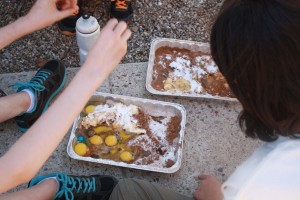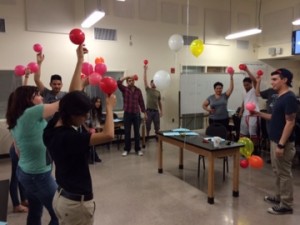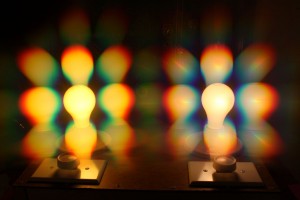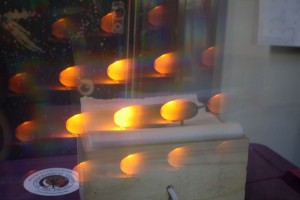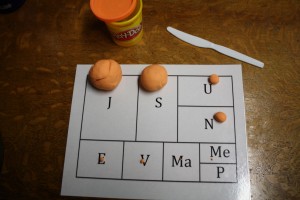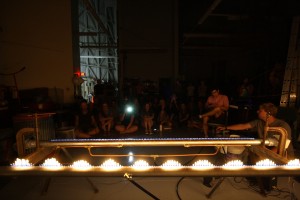Below, please find a smattering of activities that I use often at outreach events. Most can be adapted for participants of any age.
Cratering Brownies
Part 1: Cratering
Uses flour and cocoa as an analog for the lunar regolith. Creates surprisingly morphologically accurate craters (see right). Participants test sugar and flour subsurfaces and investigate the effects of velocity and composition of candy impactors on the craters they create.
This part can also be done on a larger scale with a kiddie pool filled with flour and a top layer of cocoa – good for large groups and younger kids.
Part 2: Geological “Backsolving”
After an initial round of cratering experiments, team members create a planetary topography and add the remaining brownie ingredients on top of one another in a secret order. Much as planetary geologists study planetary surfaces to glean the order of geologic events that happened in the past, the remaining team members will have to “backsolve” the order in which ingredients were added to the surface.
Part 3: Bake
If gloves are worn, can be baked afterward. Delicious and educational!
Lives of Stars
Create a three-dimensional scale model of the solar neighborhood using helium balloons. This activity is very good as an introduction to scale modeling and stellar evolution, and highlights several important things about “average” stars – that they often come in pairs or triples and that the vast majority of them are smaller even than the sun. This activity is best done without much preamble so that students can come to these conclusions themselves as they examine the model being put together.
Optional extension: “Evolve” the stars by popping them when they die. Highlights the tremendous difference between stellar lifetimes between stars.
Spectroscopy
There are lots of simple spectrographs that you can build. If you can dig up enough old black film cannisters (camera stores in town may be able to help), they make for very cheap and easy mini spectrographs. Just buy som
e grating paper (I buy mine here) and tape it over a large hole drilled or cut into the bottom of the cannister. Cut a small slit in the lid,and voila – a spectrogtaph that everyone can take home with them! Here are some of my favorite things to look at if you don’t have access to many exotic light sources:
(1) Compare a bug light and a regular lightbulb. You’ll see the spectrum of the bug light cuts off at the blue end, which is where bugs see. Use this to discuss how bugs “see”.
(3) Make a simple device where spearing a pickle between two nails completes the circuit. The pickle will emit at yellow wavelengths representative of sodium.
Play Dough Planets 2.0
An extension of the “Universe at Your Fingertips” play dough planets activity with more accurate volume calculations, that emphasizes understanding of percentages and order of magnitude estimation.
Pocket Solar System
Not my activity, but I use it often as a companion to Play Dough Planets. While the play dough activity creates a scale model in planet size, this is a simple scale model in planet separation. Most students are shocked to learn, for example, that Uranus lies at about the halfway mark between the sun and the outer solar system. A good opportunity to discuss fractions as you fold the paper.
The Earth as a Peppercorn
Another borrowed activity, and a companion to the two above. This time the scale model is accurate in both size AND separation at once. I always pause at each planet and elicit “fun facts” from participants about that planet, plus add a few of my own. When doing as a class activity, I have groups of students research each planet first and present a poster to the group. A few of my favorite things to do during this activity:
- Have the students travel “faster than the speed of light” by running from the Earth to the Sun and back (takes much less than the 16min). Very good for burning off excess energy.
- Dodge “asteroids” on the walk between Mars and Jupiter, but make sure to point out that the true asteroid belt is actually very sparsely populated.
- Compare the size of the model Sun as viewed from the model Earth to the size of the true sun in the sky (if the model is good, they should be about the same).
- Describe the distances to the nearest stars on this scale by handing out plane tickets.
Where are all the Women?
Used to open discussion about underrepresentation of women in science:

